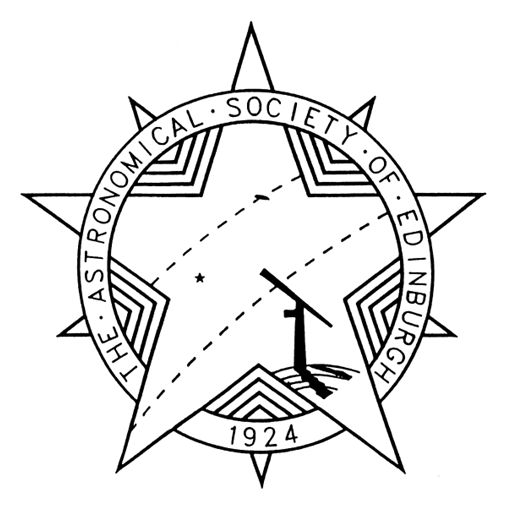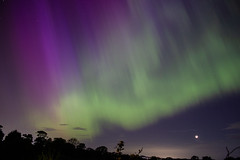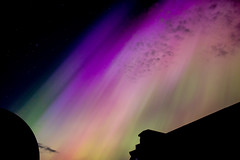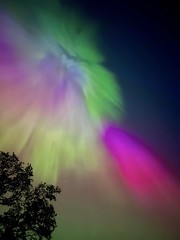Monthly Archives: January 2019
Scotland’s Sky in February, 2019
Orion and Winter Hexagon in prime-time view

The maps show the sky at 22:00 GMT on the 1st, 21:00 on the 15th and 20:00 on the 28th. An arrow depicts the motion of Mars. (Click on map to enlarge)
Even though the two brightest planets, Venus and Jupiter, hover low in the south-east before dawn, the shortest month brings what many consider to be our best evening sky of the year. After all, the unrivalled constellation of Orion is in prime position in the south, passing due south for Edinburgh one hour before our star map times. Surrounding it, and ideally placed at a convenient time for casual starwatchers, are some of the brightest stars and interesting groups in the whole sky.
I mentioned some of the sights in and around Orion last time, including the bright stars Procyon, Betelgeuse and Sirius which are prominent in the south at the map times and together form the Winter Triangle.
Like the Summer Triangle, this winter counterpart is defined as an asterism which is a pattern of stars that do not form one of the 88 constellations recognised by the International Astronomical Union. Both triangles are made up of stars in different constellations, but we also have asterisms that lie entirely within a single constellation, as, for example, the Sickle of Leo which curls above Regulus in the east-south-east at our map times, and the Plough which comprises the brighter stars of the Ursa Major, the Great Bear, climbing in the north-east.
Yet another asterism, perhaps the biggest in its class, includes the leading stars of six constellations and re-uses two members of the Winter Triangle. The Winter Hexagon takes in Sirius, Procyon, Pollux in Gemini and Capella in Auriga which lies almost overhead as Orion crosses the meridian. From Capella, the Hexagon continues downwards via Aldebaran in Taurus and Rigel at Orion’s knee back to Sirius.
Edinburgh’s sunrise/sunset times change from 08:08/16:45 on the 1st to 07:07/17:44 on the 28th. The Moon is new on the 4th and at first quarter on the 12th when it stands 12° below the Pleiades in our evening sky. The 13th sees it gliding into the Hyades, the V-shaped star cluster that lies beyond Aldebaran. Both the Pleiades and the Hyades are open clusters whose stars all formed at the same time. Another fainter cluster, Praesepe or the Beehive in Cancer, is visible through binoculars to the left of the Moon late on the 17th. Full moon is on the 19th with last quarter on the 26th.
A number of other open star clusters lie in the northern part of the Hexagon, two of them plotted on our chart. At the feet of Gemini and almost due north of Betelgeuse is M35, visible as a smudge to the unaided eye but easy though binoculars and telescopes which begin to reveal its brighter stars. It lies 3,870 ly (light years) away, as compared with 440 ly for the Pleiades and 153 ly for the Hyades. Further north in Auriga is the fainter M37 (4,500 ly) which binoculars show 7° north-east of Elnath, the star at the tip of the upper horn of Taurus. M36 (4,340 ly) and M38 (3,480 ly) lie from 4° and 6° north-west of M37.
Mars dims a little from magnitude 0.9 to 1.2 but remains the brightest object near the middle of our south-south-western evening sky, sinking westwards to set before midnight. Mars is 241 million km distant when it stands above the Moon on the 10th, with its reddish 5.8 arcseconds disk now too small to show detail through a telescope. As it tracks east-north-eastwards against the stars, it moves from Pisces to Aries and passes 1° above-right of the binocular-brightness planet Uranus (magnitude 5.8) on the 13th.
The usually elusive planet Mercury begins its best evening apparition of 2019 in the middle of the month as it begins to emerge from our west-south-western twilight. Best glimpsed through binoculars, it stands between 8° and 10° high forty minutes after sunset from the 21st and sets itself more than one hour later still. It is magnitude -0.3 on the 27th when it lies furthest from the Sun in the sky, 18°, and its small 7 arcseconds disk appears 45% illuminated.
Venus, brilliant at magnitude 4.3, rises for Edinburgh at 05:11 on the 1st and stands 8° high by 06:30 as twilight begins to invade the sky. That morning also finds it 6° above and right of the waning earthlit Moon. A telescope shows Venus to be 19 arcseconds in diameter and 62% sunlit.
Jupiter is conspicuous 9° to the right of, and slightly above, Venus on the 1st though it is one ninth as bright at magnitude -1.9. Larger and more interesting through a telescope, its 34 arcseconds disk is crossed by bands of cloud running parallel to its equator while its four main moons may be glimpsed through binoculars. Edging eastwards (to the left) in southern Ophiuchus, it is 9° east of the celebrated and distinctly red supergiant star Antares in Scorpius, a star so big that it would engulf the Earth and Mars if it switched places with our Sun.
Our third predawn planet, Saturn rises at 06:38 on the 1st and is more of a challenge being fainter (magnitude 0.6) in the twilight. One hour before Edinburgh’s sunrise on the 2nd, it lies only 2° above the horizon and less than 10 arcminutes above-right of the Moon’s edge. Watchers in south-eastern England see it slightly higher and may glimpse it emerge from behind the Moon at about 06:31.
Venus speeds eastwards through Sagittarius to pass 1.1° north of Saturn on the 18th and shine at magnitude -4.1 even lower in the morning twilight by the month’s end. By then, the Moon has come full circle to stand above-right of Jupiter on the 27th and to Jupiter’s left on the 28th.
Diary for 2019 February
2nd 07h Moon 0.6° N of Saturn
4th 21h New moon
10th 16h Moon 6° S of Mars
12th 22h First quarter
13th 20h Mars 1.1° N of Uranus
14th 04h Moon 1.7° N of Aldebaran
18th 03h Moon 0.3° S of Praesepe
18th 14h Venus 1.1° N of Saturn
19th 13h Moon 2.5° N of Regulus
19th 16h Full moon
26th 11h Last quarter
27th 01h Mercury furthest E of Sun (18°)
27th 14h Moon 2.3° N of Jupiter
Alan Pickup



